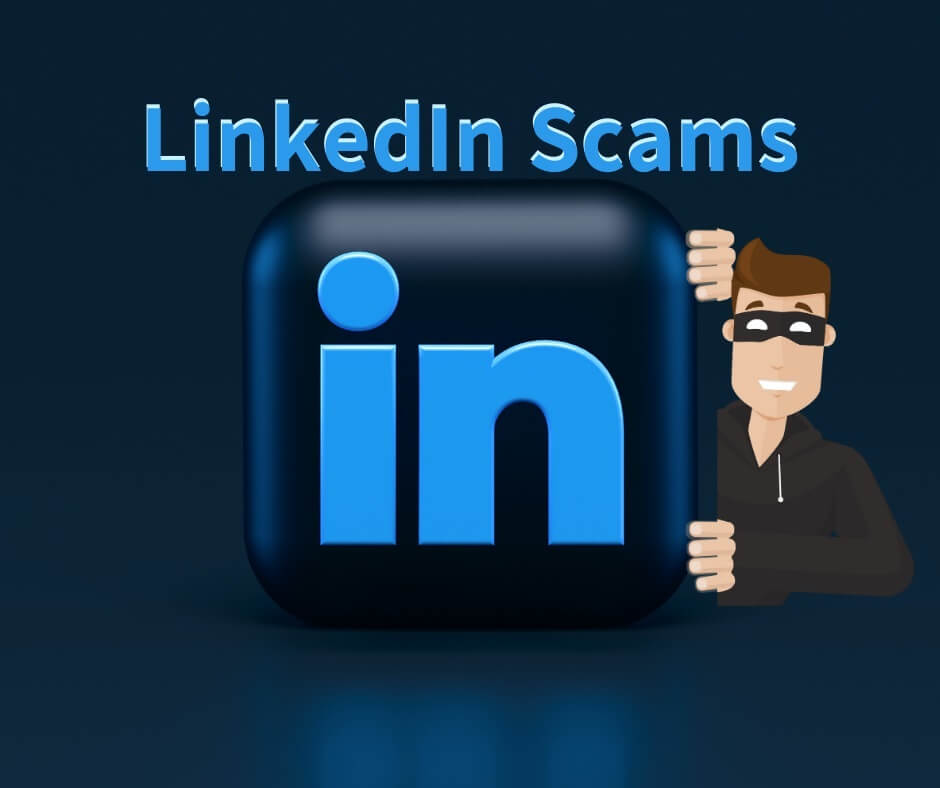Welcome to our LinkedIn Scams page where we encourage you to report online scams.
If you have fallen victim to an online scam, please leave a comment below this article.

LinkedIn, the renowned professional networking platform, has transformed the way professionals connect and build their careers.
With millions of users worldwide, LinkedIn undoubtedly offers a valuable space for forging business relationships, seeking employment opportunities, and expanding professional networks.
However, as with any online platform, LinkedIn is not immune to scams and fraudulent activities.
In this article, we delve into the world of LinkedIn scams, shedding light on the various tactics employed by scammers, offering insights on how to identify and avoid scams, and providing practical tips to protect yourself and maintain a secure professional presence on LinkedIn.
Whether you’re a seasoned LinkedIn user or just starting your professional journey, understanding the potential risks and learning how to navigate the platform safely are crucial in safeguarding your professional reputation and personal information.
Case Study
On May 9, 2023, a Georgia, USA person who reports losing $50,000 to a cryptocurrency scam filed the following complaint with the BBB (Better Business Bureau):
I was contacted through LinkedIn, and the person quickly suggested switching to WhatsApp. They offered to assist me in setting up an MT5 account for trading gold, claiming that they had made significant profits from it. Intrigued, I decided to deposit approximately $50,000 into the MT5 account and began trading.
As the total balance reached a little over $91,000, I decided to withdraw the funds via Eight Capitals. However, I was informed that I needed to pay US income tax before making the withdrawal, which I reluctantly did.
I received a total of eight emails assuring me that the funds would be transferred to my bank account within seven business days, but unfortunately, this never happened. Furthermore, they refused to acknowledge or respond to any of my subsequent emails.
The complainer provided the following details regarding the scammer:
Get in touch with our affiliated Cryptocurrency Forensic Specialists at CNC Intelligence for free by filling out the form below.
- Location: Washington, DC
- Telephone: (756) 688-9601 (an invalid number)
- Business name: Janet Davis – Crypto Investor
We can categorize this incident as a LinkedIn investment scam.
LinkedIn scams consist of fraudulent activities that specifically target LinkedIn users, leveraging the platform’s professional networking context to establish initial contact and build credibility.
Scammers may use various tactics on LinkedIn, such as posing as professionals, offering investment opportunities, or promising high returns, to deceive individuals into engaging in fraudulent activities.
In the Misleading Investment Opportunities LinkedIn scam, scammers may pose as investment professionals or companies, posting misleading information about lucrative investment opportunities on LinkedIn.
They may promise high returns or exclusive deals to entice users into investing money, only to disappear or fail to deliver on their promises.
Can scams be posted on LinkedIn?
While LinkedIn has security measures in place to prevent scams and fraudulent activities, it is still possible for scams to be posted or propagated on the platform.
LinkedIn has a large user base, and scammers may attempt to take advantage of the professional networking context to target individuals.
There are several other types of scams that can occur on LinkedIn.
Here are a few examples:
Fake Job Offers
Scammers create fake job postings or profiles on LinkedIn, offering attractive job opportunities to job seekers.
They may request personal information, such as your Social Security number or bank details, or ask for payment in exchange for job placement.
These scams aim to collect personal information or money from unsuspecting individuals.
These fraudulent job listings can lead to identity theft, financial loss, or other forms of exploitation.
Phishing Scams
LinkedIn users may receive messages or emails that appear to be from LinkedIn or reputable companies but are actually phishing attempts.
These messages often ask users to click on malicious links, enter login credentials, or download malicious attachments.
The scammers use this information to gain unauthorized access to accounts or steal personal data.
Connection Requests from Fake Profiles
Scammers create fake profiles and send connection requests to LinkedIn users.
These profiles may appear legitimate, but their purpose is to establish trust and engage in fraudulent activities such as identity theft, financial scams, or data harvesting.
Once connected, they may attempt to gather personal information, send spam or phishing messages, or engage in other fraudulent activities.
Therefore, it’s important to be cautious when accepting connection requests and verifying the authenticity of the profiles.
Romance Scams
LinkedIn romance scams are deceptive tactics employed by scammers to exploit the professional networking context of the platform for personal or financial gain.
In these scams, fraudsters create fake profiles and pose as professionals seeking romantic relationships or connections on LinkedIn.
They often target individuals who may be more vulnerable or emotionally receptive.
Here are some key characteristics and tactics associated with LinkedIn romance scams:
- Fake Profiles: Scammers create attractive and seemingly genuine profiles using stolen photos and fabricated information. These profiles may claim to be professionals in high-status positions or industries to gain credibility.
- Establishing Trust: Scammers invest time and effort into building a rapport with their targets. They engage in conversations, share personal stories, and offer emotional support to create a sense of trust and connection.
- Manipulative Techniques: Scammers use psychological tactics to exploit emotions. They may flatter their targets, express love or admiration quickly, and create a false sense of intimacy to manipulate them emotionally.
- False Identity and Intentions: Once trust is established, scammers may start sharing personal or financial troubles, claiming they need assistance or financial support. They may fabricate stories about urgent medical expenses, business ventures, or travel emergencies to elicit sympathy and financial help.
- Financial Exploitation: The ultimate goal of LinkedIn romance scams is to obtain money or financial information from their targets. Scammers may request funds through wire transfers, or gift cards, or even involve their targets in fraudulent financial activities.
Advanced Fee LinkedIn Scams
In this type of scam, scammers pose as recruiters, consultants, or business professionals offering assistance with securing lucrative contracts, investments, or partnerships.
They may request an upfront payment or fee for their services but fail to deliver on their promises, resulting in financial loss for the victims.
Identity Theft
Scammers may impersonate legitimate LinkedIn users or create fake profiles using stolen identities.
They can use the stolen information to commit identity theft, engage in fraudulent activities, or target connections within the victim’s network.
Business and Partnership LinkedIn Scams
Scammers may use LinkedIn to pose as consultants, business professionals, or entrepreneurs offering partnership opportunities or consulting services.
They may request upfront fees or payments but never deliver on their promises.
These are just a few examples of LinkedIn scams, and scammers continually come up with new tactics to deceive users.
Are people who message you on LinkedIn legit?
Not all people who message you on LinkedIn are automatically legitimate, and it’s important to exercise caution and verify their credibility before engaging further.
While LinkedIn is a professional networking platform, it is still possible for scammers or individuals with malicious intent to send messages.
How can you tell if a LinkedIn message is real?
While it’s not always easy to determine with absolute certainty if a LinkedIn message is real or a scam, there are several indicators that can help you assess its legitimacy.
Here are some tips to consider to avoid falling for LinkedIn scams:
- Profile Verification: First, check the profile of the person who sent the message. Look for indicators such as a verified badge, a complete profile with genuine work experience, and a good number of connections. Scammers often create incomplete or fake profiles.
- Relevance and Personalization: Second, consider whether the message aligns with your professional background, skills, or interests. Legitimate messages are usually tailored to your specific profile or industry. Generic or irrelevant messages may be a sign of mass messaging scams.
- Spelling and Grammar: Next, pay attention to the quality of writing in the message. Poor grammar, spelling mistakes, or awkward language can be red flags, as legitimate professionals typically maintain a certain level of professionalism in their communication.
- External Links and Attachments: Exercise caution when the message contains links or attachments, especially if they are unexpected or from unknown sources. Scammers often use these to deliver malware or phishing attempts. Avoid clicking on suspicious links or downloading unfamiliar files.
- Trust your Intuition: If something feels off or too good to be true, trust your instincts. Scammers often try to create a sense of urgency, pressure, or excitement to manipulate their targets. Take your time to assess the situation and make an informed decision.
- Research and Verification: Before engaging further, research the person who sent the message and the company they claim to represent. Look for their presence on other reputable platforms, verify their credentials, and cross-check their claims with reliable sources.
- Contact LinkedIn Support: Finally, if you suspect a message is fraudulent, report it to LinkedIn. They can investigate and take appropriate action to protect their users and maintain the integrity of the platform.
How many fake profiles are on LinkedIn?
LinkedIn has been dealing with a significant number of fake accounts, similar to other social media platforms.
For example, between January and June 2022, over 21 million fake accounts were detected and removed from LinkedIn.
Recovering Money from LinkedIn Scams
If you’ve fallen victim to a LinkedIn scam, it’s important to take immediate action.
Step 1: Report Your Scam – Leave a Comment Below
Firstly, to raise awareness and support others who may have been targeted, we invite you to share your scam experience by leaving a comment below this article.
By sharing your story, you contribute to a community-driven effort to expose LinkedIn scams and protect others from falling victim.
Step 2: Get a Free Consultation with a Cybersecurity Company
Recovering from a LinkedIn scam requires expert guidance.
Therefore, as a second step, please fill out the form on this page to receive a free consultation with a reputable cybersecurity company.
Then their experienced professionals will review your case, provide tailored advice, and guide you through the recovery process.
Step 3: Gather Evidence and Document Your Scam
In the meantime, as you await your consultation, gather all relevant evidence and document the details of your LinkedIn scam.
This includes, for example, messages, emails, transaction records, and any other information that can strengthen your case.
Organizing your evidence will help cybersecurity experts understand the specifics of your situation and assist you more effectively.
Step 4: Report LinkedIn Scams
In parallel with seeking cybersecurity assistance, report the scam to LinkedIn through their official channels.
Additionally, file a complaint with your local law enforcement authorities.
At this point, provide them with the evidence you have collected and be prepared to cooperate throughout their investigation.
Reporting the scam to both LinkedIn and law enforcement agencies increases the chances of holding the scammers accountable.
Remember, time is of the essence when recovering from a LinkedIn scam.
If you have fallen victim to online scams, please comment below. If you have suffered a substantial financial loss, do not despair. We are here to assist you in recovering your funds!
When you comment, your name, comment, and the timestamp will be public. We also store this data, which may be used for research or content creation in accordance with our Privacy Policy. By commenting, you consent to these terms.

